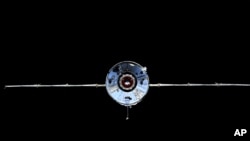Russian space officials said Friday that a software malfunction had caused the unexpected firing of thrusters on a newly arrived module, moving the International Space Station out of its intended attitude.
The incident occurred Thursday, hours after the long-delayed Russian laboratory module, known as Nauka, docked with the ISS. It took mission controllers nearly an hour to reposition the ISS, which had been bumped 45 degrees out of alignment. Ground controllers fired Russian thrusters on other Russian elements at the station to fix the positioning.
In a statement Friday, ISS Russian segment flight director Vladimir Solovyov said the software failure had prompted a direct command to turn on the module’s engines.
Communications between the ground and the crew went out twice for several minutes, but in a statement, the U.S. space agency NASA said the ISS crew was never in danger.
On Twitter Friday, Russian cosmonaut Oleg Novitsky said not to worry and the work to integrate the new module into the ISS was continuing as scheduled.
The Russian unmanned, 20-ton, nearly 13-meter-long Nauka module — also known as the Multipurpose Laboratory Module — docked with the ISS following a long and, at times, uncertain journey.
Nauka is now the first new module in the Russian segment of the station since 2010.
The troubled trip to the orbiting space station followed years of problems getting the module off the ground. Nauka — designed to provide more room for scientific experiments and space for the crew — was initially scheduled to launch in 2007 but was repeatedly delayed because of technical problems.






